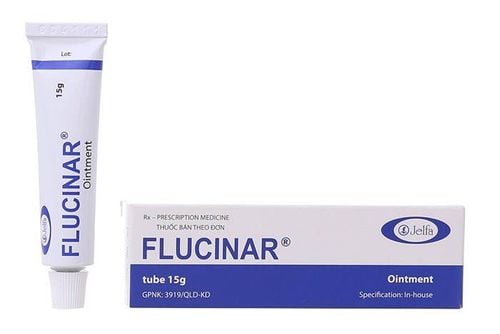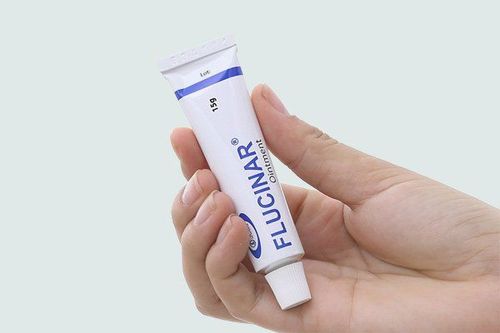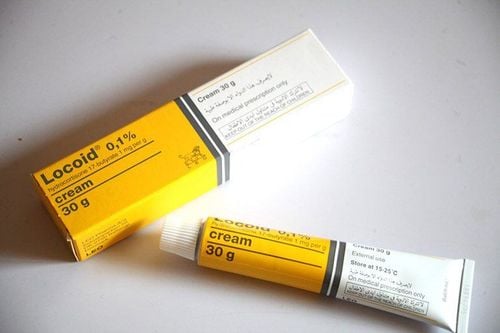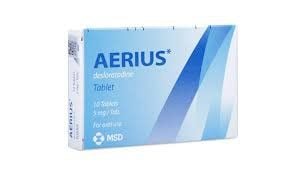Flucinar is an ointment that contains the active ingredient Fluocinolone Acetonide. It is used for short-term treatment of skin conditions such as dry, non-infected dermatitis that responds to steroids, seborrheic dermatitis, hives, and certain genetic skin issues. The following article will explain its uses and how to apply Flucinar properly.
1. Uses of Flucinar
1.1. Indications
What is Flucinar? Flucinar is an ointment containing the active ingredient Fluocinolone acetonide. It is used to treat the following conditions:
- Short-term management of severe or acute non-infectious dry skin inflammation that responds to glucocorticoids, persistent itching, and thickened skin.
- Inherited skin inflammation, seborrheic dermatitis, eczema, lichen planus, hives caused by lichen disease, lupus erythematosus, polymorphic erythema, and chronic psoriasis.
1.2. Pharmacodynamics
Fluocinolone acetonide is a synthetic corticosteroid with moderate strength. It contains fluorine in its structure, which enhances its effectiveness. Like other topical corticosteroids, it works in three main ways include Anti-inflammatory, vasoconstrictive, and anti-allergic effect. Anti-inflammatory effect: It reduces the formation and release of substances (like histamines and prostaglandins) that cause swelling, redness, and inflammation, vasoconstrictive effect: It narrows blood vessels at the inflamed area, reducing fluid leakage and swelling, Anti-allergic effect: It helps to calm allergic skin reactions.
Fluocinolone acetonide also reduces the permeability of cell membranes, slows down protein buildup, and decreases the production of collagen in the skin. This helps control excessive skin growth and inflammation.
However, repeated use can make the skin less responsive to the medication, prolong the time it takes to work, increase the drug’s absorption into the bloodstream, and raise the risk of side effects.

1.3. Pharmacokinetics
- Absorption process: Topical corticosteroids should only be used on intact skin. A small amount of the medication is absorbed into the deeper layers of the skin and then enters the bloodstream. However, the amount absorbed into the body increases if the skin has lost its protective layer, has skin conditions (like eczema or psoriasis), or is inflamed. The amount absorbed also depends on the condition of the skin, how easily the medication can pass through, and how much is applied. The medication is absorbed most easily in areas such as the eyelids (40%), scrotum (36%), forehead (7%), forearms (1%), scalp (4%), and skin folds. Fluocinolone acetonide can be found in the body about 15 days after use.
- Metabolism process: Topical corticosteroids are not broken down in the skin. When used as directed, a small amount is absorbed into the bloodstream and processed in the liver into inactive substances.
- Excretion process: Fluocinolone acetonide is eliminated by the kidneys in the form of sulfate, glucuronide, and other inactive forms. A small amount of the medication is also excreted in the stool.
2. Dosage of Flucinar
Besides understanding what Flucinar does, it’s important to know the right dosage and how to use it. The recommended dosage is as follows:
- Apply a small amount to the affected skin area, no more than 1–2 times a day. Don’t cover the treated area with bandages unless prescribed for psoriasis.
- Do not use it continuously for more than 2 weeks on the body or more than 1 week on the face. Do not use more than 1 tube per week.
- Be cautious when using Flucinar on children under 2 years old (only use it when absolutely necessary and as prescribed by a doctor).

3. Side Effects
Some possible side effects from using Flucinar topical medication include:
- Skin rashes, acne, thinning of the skin, reduced skin growth, dry skin, hair loss or excessive hair growth, blood vessel widening, changes in skin color, skin thinning or cracking;
- In some cases, hives, skin irritation at the application site, or raised rashes may occur;
- Covering the skin after applying the medication can increase absorption, which may lead to side effects like swelling, weakened immune system, and high blood pressure;
- Applying the medication near the eyes may cause cataracts or glaucoma.
4. Precautions when using Flucinar
4.1. Contraindications
Flucinar should not be used in the following situations:
- Skin infections, viral infections, fungal infections, rosacea, seborrheic dermatitis, perioral dermatitis;
- After receiving a vaccine;
- If the patient is allergic to fluocinolone acetonide, other corticosteroids, or any ingredients in the medication;
- Children under 2 years old.
4.2. Important Notes
Some important things to keep in mind when using Flucinar:
- Don’t use it for more than 2 weeks, as this can increase the risk of side effects like high blood pressure, swelling, and weakened immune function;
- Long-term use may reduce the body’s natural production of certain hormones, like ACTH, leading to lower cortisol levels and a condition called Cushing’s syndrome, but this usually goes away once the medication is stopped;
- If patients have a fungal or bacterial infection where the medication is applied, it should be treated with the appropriate antifungal or antibacterial;
- Minimize use of the medication around the eyes for people with narrow-angle or wide-angle glaucoma or cataracts, as it can worsen these conditions;
- Only use the medication on facial or groin skin when absolutely necessary, as these areas absorb the medication more easily and can increase the risk of side effects;
- Be cautious when using Flucinar in people with thinning skin, especially elderly individuals.
5. Effects of drugs on Special Populations
- Pregnant women: Animal studies suggest that corticosteroids can cause birth defects, even with topical use. However, there is no human research confirming harm to the baby. Flucinar should only be used during pregnancy if the benefits outweigh the risks, and it should not be used in the first 3 months of pregnancy.
- Breastfeeding women: There is no research showing whether the medication passes into breast milk. However, it should be used with caution while breastfeeding.
Flucinar is used for short-term treatment of conditions like non-infectious dry skin, seborrheic dermatitis, hives, and genetic skin conditions that respond to corticosteroids. To avoid side effects and ensure the medication works properly, patients should follow the usage instructions carefully.
To arrange an appointment, please call HOTLINE or make your reservation directly HERE. You may also download the MyVinmec app to schedule appointments faster and manage your reservations more conveniently.









